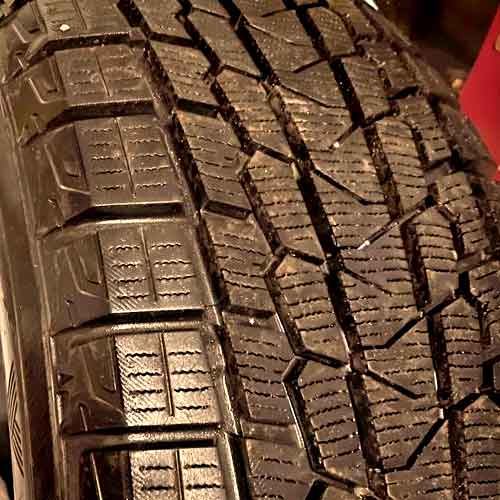Both the Bridgestone Blizzak WS90 and the Yokohama Ice Guard IG53 are masters of their own game in the winter tire market. So let me dissect their individual performance in various terrains, and weather conditions, helping you make an informed decision for your next tire purchase.

Table of Contents
Tire Sizes
The The Bridgestone Blizzak WS90 (review) comes in 52 total sizes in 15 to 19 inches (wheels) with following specs.
- Speed ratings: T or H.
- Load ratings: SL or XL.
- Tread depth: 11 or 12/32″.
- Weight: 17 to 29 lbs.
- Tread warranty: None.
On the other side, the Yokohama Ice Guard IG53 comes in 14 to 18″ with following specs.
- Speed ratings: H and T.
- Load ratings: SL and XL.
- Tread depth: 11 and 12/32″.
- Weight: 16 to 36 lbs.
- Tread warranty: None.
Tread Appearance
The Bridgestone Blizzak WS90 is a strong winter tire with a very well-designed tread pattern. Let’s explore its details more.

The tread consists of three primary sections, or “ribs”, and I’ll examine each of these in turn.
Let’s begin with the shoulder lugs.
So these are packed with numerous biters, you get lateral notches facing the center of the tire, combined with the longitudinal slits (located at middle of these lugs).
And further out, you also get zigzag slits too.
And yes, of course, there’s ton of siping here, stating the obvious.
The central rib is continuous running, so no blocks there.
This rib has similar-to-shoulder slits (and sipes). These slits join up with the V shaped notches, which face both directions laterally.
On the other hand, Yokohama Ice Guard IG53 also features a directional pattern.

When you break down the tread, you can see it’s got 7 ribs, which are like column of blocks in the middle.
These column make up 6 channels that go from one end of the tire to the other.
The middle-most column is just one piece, because the slits don’t cut it into blocks (well, not all the way). But you can picture triangles being formed there.
These are made by incisions, which basically act as in-groove notches, supplying bite on snowy terrains.
And that bite get further aided by the ribs sharp off-set edges and a ton of siping.
The surrounding two ribs have blocks with similar features, but with slightly open design. Though they are still connected to each other longitudinally.
Moving towards shoulders, lugs are very blocky, have longitudinal slits, and similar wave-like pattern like seen elsewhere.
Snow Performance
In the realm of snowy conditions, both boys delivered exceptional performance, despite the unique challenges each type of snow presented. However, the Yokohama Ice Guard IG53 emerged as a stronger contender in terms of traction, especially on slightly fluffy snow terrains.
The reason? Well, answer lies within its intricately designed treads.
Its more aggressive directional tread pattern, adorned with lugs possessing a more open design, equips the tire with an advantageous edge, facilitating better snow-to-snow contact.
The fluffy snow particles find themselves easily snatched up by the tire’s interlocking grooves and snow-vices. Once trapped, these particles enhance the tire’s grip on the ground, providing a superior traction experience as snow inherently sticks better to its own kind than to rubber.
In contrast, the Bridgestone Blizzak WS90’s design is more closed up, even though both tires features a continuous running central rib.
Moreover, its missing interlocking groove structure, on top, don’t allow the tire to pick up as much snow as its competitor, resulting in slightly diminished performance in snow-ridden conditions.
So overall Yokohama has the upper hand here.
Ice Performance
Moving on to icy conditions, the Bridgestone Blizzak WS90 showcases superior capabilities, most notably in its average braking distance, which is significantly shorter compared to its counterpart.
A comparative test between the two shows that on average, the Blizzak came to a stop a whopping 15 feet shorter.
So why is that the case?
Well, because the Blizzak tire is adorned with intricate biters of various widths, presenting slanted incisions, V-shaped notches facing both lateral directions, and abundant siping.
All these elements contribute to the tire’s heightened ability to grip and bite onto ice. Additionally, these biters feature dual angles, further enhancing grip and shortening braking distance.
On the other side, the Yokohama Ice Guard IG53 struggles with its larger tread voids and fewer notches.
It falters particularly in effective braking, where the central tread area is crucial. With wider lateral tread voids, it struggles to secure a firm grip on packed ice. The lack of multi-angled siping further accentuates the tire’s shortcomings, leading to a longer handling time compared to its competition.
Wet Traction
Tread design and rubber compound largely dictate a tire’s wet traction capabilities.
And in this aspect, although both tires come armed with ample siping and soft, thermally adaptive rubbers, the Bridgestone Blizzak WS90 still gets to take the lead. Let me explain why.
So sipes basically work by expelling air out and sucking water particles in. And Blizzak with dual siping structures composed of more aggressive interlocking, and rectilinear ones provide better biting abilities on icy terrains.
Moreover, all its sipes also have multiple angles, so they are able to wipe water off in all directions, as the tire corners, brakes or accelerates.
On the other side, the Yokohama Ice Guard IG53’s siping takes a different approach, featuring only a lateral orientation, so you can not get the similar results with this tire.
Though yes, its performance is much more commendable when we look at its hydroplaning resistance.
In both curved and straight aquaplaning tests, the tire delivered slightly higher speeds. This improved performance can be attributed to its interconnected web of grooves which disperse water in all directions more effectively than its counterpart’s continuous central rib.
Dry Traction
When considering dry traction, two key components come to the fore: directional grip and lateral traction.
And here, the Blizzak WS90 outperforms with its continuous running rib providing consistent contact with the surface. This translates into shorter braking distances and quicker acceleration times.
However, the Yokohama, with its wider grooves, cannot quite match its competitor’s performance.
And yes, compounding the issue, the Ice Guard’s more substantial structure leads to increased lug movement as the tire corners, resulting in diminished steering feedback.
So overall you get a better handling and directional grip on Bridgestone WS90.
Comfort Levels
Comfort in a tire involves a delicate interplay of factors such as road noise and vibration absorption, both influenced by the tire’s tread pattern, and sidewall design.
In terms of tread noise, the Blizzak WS90 performs slightly better, due to its less-voided tread design, so it doesn’t allow as much air to come in and strike around (generating noise).
And with its lighter weight, it also features quicker response times, allowing for a smoother overall ride compared to its counterpart.
However, the Yokohama Ice Guard IG53 does have an advantage with its softer rubber compound, which is better at cushioning road bumps compared to the Blizzak.
But yes, the WS90 in comparison is quieter.
Fuel Economy
Fuel usage in a tire is largely dictated by its stickiness with the surface and its overall weight.
In both these aspects, the Yokohama Ice Guard IG53 falls short, with its significant weight and relatively broader tread voids yielding increased friction as the tire rolls on the surface.
Despite a noticeable increase in performance in extreme winter temperatures, the tires’s shortcomings in this regard are undeniable.
In contrast, the Bridgestone Blizzak WS90, with its lighter structure and longitudinally aligned ribs, provides a more streamlined travel experience, particularly for straight-line travel such as on highways.
This design leads to more efficient fuel consumption by minimizing energy expenditure.
So overall things are better with Blizzak WS90.
Tread Life
Rolling resistance is also a determinant of tread longevity.
And in this regard, the Blizzak outperforms the Yokohama Ice Guard IG53.
Let me explain why.
So basically, WS90 comes with a lighter structure, which exerts a smaller overall amount of force on its tread blocks, generating less friction and slower wear.
On the other side, on Yokohama’s tire, the opposite happens. Here, you have larger weight (on average), and a smaller overall rubber area, where that weight would go.
So each of its lugs bears more weight pressure on itself, and rubs against the road with a greater amount of friction.
This burns down the tire’s rubber directly and also generates heat, which is the worst enemy of winter tires.
However, it’s worth noting that the performance difference between the two is marginal, which may explain why neither tire offers any warranties.
The Bridgestone tire offers a longer tread life, comparatively.
Summing Up
So let me summarize all of the above.
- Yokohama Ice Guard IG53 exhibits superior traction in snowy conditions due to its aggressive directional tread pattern, which facilitates better snow-to-snow contact.
- In icy conditions, Bridgestone Blizzak WS90 excels with shorter braking distances owing to its intricate biters and dual-angle siping.
- In terms of wet traction, Blizzak’s siping structure surpasses its competitor’s lateral-only orientation. However, Ice Guard performs better in hydroplaning resistance tests.
- For dry traction, Blizzak’s continuous running rib grants superior directional grip and handling.
- Comfort levels are similar, but Blizzak is quieter, while Ice Guard provides better bump cushioning.
- The Blizzak also offers better fuel economy and tread life due to its lighter structure and longitudinally aligned ribs. The performance difference between the two, however, is marginal.